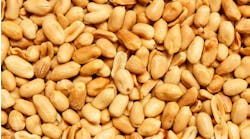It may seem like a broken record or some strange rewrite of the movie “Groundhog Day,” but as the food & beverage industry moves into 2024, it does so with a sneakily similar strain of cautious optimism as a year ago, despite 12 months of ups, downs and end-arounds for the economy and the industry.
This year, the building optimism is founded upon an easing outlook on inflation and food prices — in large part because consumers have balked, finally, against high food prices in many cases.
“Firms have backed off raising prices given the strain that consumers are under, and we’ve seen maybe not a retrenchment or a deflationary environment, but more so a stabilization,” says Erin Lash, director of consumer equity research for Morningstar Research Services (www.morningstar.com). “That has given firms the fuel through which to offset some of those headwinds that they've been facing.”
In addition, she adds, there has been smoother sailing in the supply chain, which pinned down growth in 2022 into early 2023.
“Supply/demand imbalances that had been so pronounced over the past several years have started to moderate, unlocking the potential for further cost savings initiatives and a more significant lever firms can pull, again, to offset some headwinds,” Lash says.
With a smoother path forward and some reason to push the accelerator, food & beverage processors could even see a bump in volume this year, explains Sally Lyons Wyatt, global executive vice president and chief advisor in consumer goods and foodservice insights for Circana (www.circana.com).
“We have started to see prices stabilize — they’re still 30% higher than 2019, but they've stabilized, and we're not seeing the month-over-month double-digit increases,” she says. “That is helping fuel what we think will be a bit of a rebound on volume — about a 1% increase on volume for food.”
She says volumes began to show signs of rebound in Q3 of 2023, as consumers began to react to rising costs by beginning to shift toward a “do it yourself” and “maintain and upkeep” mentality. Rather than buying a new car, consumers were spending on upkeep; instead of going to the doctor for less urgent personal care reasons, they were looking for self-care, self-medication options. Food & beverage spending benefitted from some of those trends.
“All of that is positive for food & beverage’s share of the consumer wallet,” Lyons Wyatt says. “And when you see the rate of increase in prices starting to decline and prices stabilizing, the volumes are starting to rebound.”
However, the industry isn’t oblivious to past surprises, and that’s where the caution comes into play, explains Geoff Coltman, senior vice president for Catena Solutions (www.catenasolutions.com).
“Food & beverage as a whole is still an entire industry fraught with change, and there’s still a lot of work to be done,” he says. “But Americans’ appetites and demand are still high, and they’re looking for food & beverage to meet it, so we’re still pretty bullish on the industry moving into 2024.”
Lyons Wyatt affirms companies appear better prepared for changes heading into 2024 following several turbulent years.
“It’s always, ‘What’s around the corner; what’s next?’” she says. “We all know there’s going to be something that comes up, so we all need to keep working to manage these situations to the best of our abilities and stay prepared.”
Segments where value will win
Lyons Wyatt and the Circana team believe beverages and deli will outperform the 1% volume growth they’ve predicted for total retail foods and beverages. Those expectations are driven by the value propositions each segment brings to the table.
“The theme I’ve been saying will drive 2024 is value,” she says. Value means different things to different consumers; some seek value in terms of price, while others view value based on affordable luxuries, where they are willing to pay for the higher-quality experience. “When we look at the categories and products that are winning, they fall on both sides of the spectrum.”
For beverages, value comes in the form of functional benefits to consumers nowadays. Consumers are turning to “hydration plus something,” according to Lyons Wyatt, and that’s giving the beverage outlook a boost.
“Whether protein, energy, antioxidants, immunity, brain health or something else, those products are doing well and commanding a little higher price,” she adds, “and I don’t see that necessarily waning in the next year.”
Coltman concurs that growth in beverage diversification should continue, especially with more products offering a health and wellness value proposition. He points to a recent move by restaurant behemoth McDonald’s as a perfect indicator of the potential in beverages.
In December, McDonald’s opened a single CosMc’s restaurant in suburban Chicago, a concept heavy on novel beverages (turmeric spiced lattes, dragonfruit SpiceAde and boba energy drinks) along with a few “bites” like Apple Cinnamon McPops plus Egg McMuffins.
“McDonald’s is a very smart organization and wouldn’t just take a chance with a new restaurant unless there was something there, where they see people seeking beverage diversification,” he says. “It will be interesting to see how CosMc’s competes in made drinks, but even Starbucks, in general, is looking to increase its store count.”
On the deli side, the old standby of convenience continues to push the segment ahead. Lyons Wyatt clarifies that it’s not necessarily the service side of the deli that’s primed and ready to take off, but the grab-and-go products, where they might offer a ready-made entrée or a product with some cheese, meat and bread together for a quick, affordable meal.
“For those that need a lower price point of entry, instead of buying a larger package of meat at once, they can come in and get a smaller item at a lower price for a just-in-time occasion,” she explains. “The ready-made entrees can be taken home, heated up and eaten, and we’ve seen an uptick at retail foodservice in the p.m. for grab-and-go items.”
Lash sees a bifurcation in consumers’ perception of value as well, evident in the variety of pack sizes that are seeing growth in the marketplace.
“Some [consumers] are looking to the club store channel to a much greater extent to buy in bulk at a lower unit price, while others have favored the lower price, discount store channel, which means a smaller pack size and higher per unit price — but a lower outlay from an absolute dollar perspective,” she says. “It’s key for manufacturers to have breadth and depth in their portfolio’s pack sizes, so they have products positioned in each of those areas.”
Challenges remain for other categories
The upcoming year won’t be fun and games for the entire food & beverage industry, however. Headwinds are expected to make growth a significant challenge for several segments. Lyons Wyatt says Circana believes the frozen foods segment, as well as the meat department and liquor, could be fighting uphill battles in 2024.
“Frozen foods serve so many positive needs, from convenience to less waste, from the varieties of cuisines and flavors to the novelty of some items as well,” she explains. “But the price increases have turned some people away because they can’t justify stretching their dollar past what they can afford for frozen foods.”
Lyons Wyatt believes consumers have gotten more savvy about looking at price per serving when it comes to frozen foods and shifting their tight budget dollars toward purchasing items like rice and pasta, which don’t top their spending thresholds. All that said, she doesn’t expect frozen to stay down for long.
“Speed to table is a big deal for consumers, and especially for those that have air fryers and other appliances that can cook frozen foods fast, so frozen will be in consideration again soon,” Lyons Wyatt says. “Frozen will come back, but it’s facing a bit of a hurdle right now over what happened with prices over the last year or two.”
In the liquor department, companies are up against a sea change in consumption, Lyons Wyatt says, with the younger generation not consuming alcohol in the same ways as the older generations have done so.
“They’re not the wine generation, from what our experts are telling us; they’re more about having maybe a premium beer,” she says. “And liquor is another category where some consumers have decided to pull back on their spending because prices have gotten too expensive for them.”
Bars and restaurants are working hard to respond, using novel products like craft cocktails as a lure to get consumers in the doors. Although that’s an attractive item to many, “they can cost upwards of $20, which is appealing to those with the means to afford it, but not the 60% of the population that is living paycheck to paycheck,” according to Lyons Wyatt.
When it comes to meat, Circana sees not only prices affecting the segment, but the sheer variety and type of value consumers are seeking in meat impacting the category as well.
“We’ve seen a lot of change in the types of meat cuts that consumers are buying, and we think that might continue in 2024,” Lyons Wyatt says. “Therefore the volumes just won’t be there, because consumers are trying to buy cuts that can help them stretch a meal where they have dinner and enough left over for lunch the next day too.”
Coltman says red meat could struggle for the foreseeable future, and points to the changing habits of the younger generations with regard to shopping and cooking meals at home.
“Buying habits are changing, and the ‘meat and potato’ world that we grew up in just isn’t there anymore today,” he explains. “The protein industry is going to be hurting and in a tough spot for some time still.”
No matter the segment, industry growth could be hampered by any negative fluctuation in the labor market, Lyons Wyatt says. Consumers simply need to be gainfully employed, making money and then spending that money on food and beverage on a daily, weekly basis.
“What has helped us be cautiously optimistic is the labor market, in which people have jobs and are earning wages,” she says. “But, if that changes, then the volume being purchased goes down because too many consumers are unemployed, and that would change the outlook.”
The bigger economic picture
On a larger economic scale, Lyons Wyatt says companies will need to monitor what happens with the cost of consumer credit — which has been rising — interest rates and the depletion of savings due to the higher costs brought on by inflation after the pandemic ended. Lash says Morningstar sees the better balance in supply chain as a catalyst for added pressure on sales and profitability.
“When supply and demand imbalances are so pronounced, manufacturers have little motivation to promote,” she says. “Now that we’ve had moderation and a rebalancing, we think competitive and promotional intensity will step up, which would further pressure sales and profitability.”
Companies that have pushed the accelerator on innovation have found some success, Lyons Wyatt says, but they need to continue working to price products accordingly.
“When we looked at manufacturers that were growing, we found they were strategically or surgically pricing their portfolio, taking price where they could on the affordable luxury products that could command a higher price point, and taking prices down on some of their core items in order to turn more product,” she says.
“I think that balancing will be a strategy more companies take over time, because we’ve seen both super-premium and private label gaining some share over the past year, though private label has slowed in the second half.”
Lash adds that consumer-centric innovation — and clear communication on value — can help processors protect their margins in a marketplace that continues to pressure consumers on price.
“Firms that continue to bring consumer-valued innovation to market are in a better position to continue to win and thwart any trade down to lower-priced options,” she says. “When consumers recognize the added value, we’ve seen that they are willing to pay a higher price.”
To compete in 2024, Lyons Wyatt says, companies will need to play up any and all value propositions across their entire portfolio, meeting the needs of a bifurcated audience.
“Get people excited about innovation and new products, get consumers to try them, but also get that story out about the product innovations that have been out there that consumers may have forgotten about, whether it’s convenience or speed to table or some other innovation,” Lyons Wyatt says.
Remaining optimistic with so many unknowns can be challenging, and the industry has seen storms arise from clear skies before — so cautious steps forward are understandable as well. However, as Coltman reminds, preparation and agility are the key to weathering whatever challenge comes next.
“You’re never going to get rid of the haunts: There’s always going to be the ‘next thing’ to work through,” he says. “With the food industry, it’s about being agile, understanding planning and having your contingencies ready when the next disruption happens.”
The new year — like every year prior — promises nothing. But food & beverage processors armed with the proper planning can act, rather than react, and grow their businesses in 2024 with so many challenges of the past year behind them.




